Museums in Alanya
 There are four museums in Alanya. These are the Museum of Archaeology, that of Ethnography, Museum of İçkale and Museum of AtatürkÕs House. All of the museums are under control of the Head Office of Museums in Alanya and you have to pay for a visit. They are all open to visitors during the week except for lunch breaks.
There are four museums in Alanya. These are the Museum of Archaeology, that of Ethnography, Museum of İçkale and Museum of AtatürkÕs House. All of the museums are under control of the Head Office of Museums in Alanya and you have to pay for a visit. They are all open to visitors during the week except for lunch breaks.
The most important work in Alanya is the statue of Heracleus exhibited in the museum of Archaeology. Kızılkule in the harbour is designed as the museum of Ethnography. İçkale, built as the palace of the Sultan Alaaddin during the reconstruction of the city in the 13th century, is now a museum and open to visitors.
The Head Office of Museums: Hilmibağcı Caddesi, Damlataş Alanya Phone: (242) 513 12 28.
Museum of Archaeology
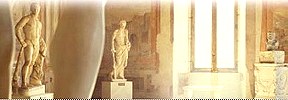 The Museum of Archaeology in Alanya opened in 1967, on the arrival of articles of Bronze Age, and those belonged to Urartu, Frig and Lidya from the Museum of Anatolian Civilization in Ankara. The museum has been enriched with the work found in the excavations that have been carried out recently. The museum has a part of archeology and a part of ethnography. The oldest article found near Alanya and exhibited in the archaeology clivision of the museum is a stone inscription written in phoenician language and it dates back to 625 BC. The statue of Heracleus, made of bronze and dating back to 2nd century BC is exhibited in another part. There are vast collections of ash boxes and coins in the Museum of Archaeology in Alanya, along with the things found and belonging to the archaic, classical and Byzantine era, the Hellen period and these are made of bronze, marble, fired soil, glass and mosaic. Furthermore, the museum has works of Turkish-Islamic world of Selcuks and Ottomans. In the division of ethnography there are things like carpets of Turkoman nomadic tribes, colourful sacks, saddle-bags, clothes, samples of ornaments, guns, household goods for daily use, accessories, manuscripts and writing sets that have been collected from the surrounding areas and reflecting the folkloric character of the region and a room of a old Alanya house are all exhibited. There are also stone works of Romans, Byzantine and Islamic periods in the garden of the museum. You have to pay for a visit to the museum which is open during the whole week.
The Museum of Archaeology in Alanya opened in 1967, on the arrival of articles of Bronze Age, and those belonged to Urartu, Frig and Lidya from the Museum of Anatolian Civilization in Ankara. The museum has been enriched with the work found in the excavations that have been carried out recently. The museum has a part of archeology and a part of ethnography. The oldest article found near Alanya and exhibited in the archaeology clivision of the museum is a stone inscription written in phoenician language and it dates back to 625 BC. The statue of Heracleus, made of bronze and dating back to 2nd century BC is exhibited in another part. There are vast collections of ash boxes and coins in the Museum of Archaeology in Alanya, along with the things found and belonging to the archaic, classical and Byzantine era, the Hellen period and these are made of bronze, marble, fired soil, glass and mosaic. Furthermore, the museum has works of Turkish-Islamic world of Selcuks and Ottomans. In the division of ethnography there are things like carpets of Turkoman nomadic tribes, colourful sacks, saddle-bags, clothes, samples of ornaments, guns, household goods for daily use, accessories, manuscripts and writing sets that have been collected from the surrounding areas and reflecting the folkloric character of the region and a room of a old Alanya house are all exhibited. There are also stone works of Romans, Byzantine and Islamic periods in the garden of the museum. You have to pay for a visit to the museum which is open during the whole week.
Heracleus
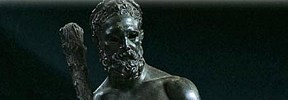 Heracles, the son of Zeus, the father of gods in mythology, and mortal Alkmene, represents the irresistible power of human being to attack and bear against nature. Hera, the jealous wife of Zeus, never let Heracleus alone from birth to death, because of her hatred. Heracleus was semi-god but a human at the same time and also he was a slave. Although he had a power gifted by gods he never enjoyed using the power, he had not wanted to be a hero. He committed crime involuntarily since he couldnÕt control his power and sometimes felt as if the would go mad. He was asked to fulfill twelve tasks in order to compensate the bad things he had done. He would be an immortal entity if he could do his services that would last twelve years. He had a life full of adventures, using his muscles and a mace that he used as a gun and always carried with him. The fur-skin in his hand represented in his statues was what he used as an armour after he had strangled the lion of Nemea in his arms. Heracleus, who was always a man of good deeds, returned to his land after being successful but his omnious fate never left him. He felt great pain when he put a shirt with a poisonous potion on his bady. Thus, he ordered her son to prepare a bonfire and he died in fire. Zeus interfered with that tragedy and he took Heracleus with him; so, Heracleus, who never went back, married Hebe and became immortal. Heracleus is also known as Hercules in mythology.
Heracles, the son of Zeus, the father of gods in mythology, and mortal Alkmene, represents the irresistible power of human being to attack and bear against nature. Hera, the jealous wife of Zeus, never let Heracleus alone from birth to death, because of her hatred. Heracleus was semi-god but a human at the same time and also he was a slave. Although he had a power gifted by gods he never enjoyed using the power, he had not wanted to be a hero. He committed crime involuntarily since he couldnÕt control his power and sometimes felt as if the would go mad. He was asked to fulfill twelve tasks in order to compensate the bad things he had done. He would be an immortal entity if he could do his services that would last twelve years. He had a life full of adventures, using his muscles and a mace that he used as a gun and always carried with him. The fur-skin in his hand represented in his statues was what he used as an armour after he had strangled the lion of Nemea in his arms. Heracleus, who was always a man of good deeds, returned to his land after being successful but his omnious fate never left him. He felt great pain when he put a shirt with a poisonous potion on his bady. Thus, he ordered her son to prepare a bonfire and he died in fire. Zeus interfered with that tragedy and he took Heracleus with him; so, Heracleus, who never went back, married Hebe and became immortal. Heracleus is also known as Hercules in mythology.
Museum of Ethnography
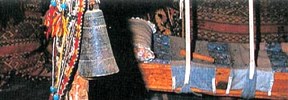 Kızılkule, which is in the harbour and is a work of Selcuks of the 13th century, is at the same time the museum of ethnography. The ground floor and the first floor of the five-storey tower have been designed as museums. In the museum there are carpets, rugs, clothes, household goods, guns, scales, devices of illumination, and looms peculiar to Alanya and ethnographic works like the tent representing the Turkoman nomadic tribe culture in the Taurus Mountains. Sometimes that historical building welcomes cultural or art activities such as exhibitions of painting or classical music concerts. You can catch a view of the panoramic landscape of the eastern part of the city and the way of settlement on the historical peninsula at the top floor of the tower. Moreover, you can go to the walls from the tower and walk feeling history. You have to pay for a visit to Red Tower.
Kızılkule, which is in the harbour and is a work of Selcuks of the 13th century, is at the same time the museum of ethnography. The ground floor and the first floor of the five-storey tower have been designed as museums. In the museum there are carpets, rugs, clothes, household goods, guns, scales, devices of illumination, and looms peculiar to Alanya and ethnographic works like the tent representing the Turkoman nomadic tribe culture in the Taurus Mountains. Sometimes that historical building welcomes cultural or art activities such as exhibitions of painting or classical music concerts. You can catch a view of the panoramic landscape of the eastern part of the city and the way of settlement on the historical peninsula at the top floor of the tower. Moreover, you can go to the walls from the tower and walk feeling history. You have to pay for a visit to Red Tower.
Museum of İçkale
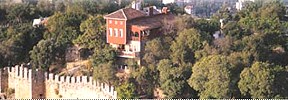 It is in the historical citadel, at the peak of the peninsula lying towards the Mediterranean. The palace of Alaaddin Keykubat, the Sultan of Selcuks was found as the result of the excavations carried out for years. Some excavations are still in progress. There’s a little church of Byzantine Period, just opposite the ruins of the palace in İçkale. The church known as the church of Aya Yorgi or of Hagios Georgios is thought to have been built in the 6th century. It is like a clover in shape and the only building that does not belong to Selcuks Period in İçkale, and it can be seen today as a proof of their tolerance for different religions. There are traces of frescos, however rare, on the inner walls of the church. From the part called Seyirlik in İçkale you can see the Taurus Mountains above and the western wing of Alanya below. The cistern on a cliff in İçkale is known as Adam Atacağı. According to a legend, those who were sentenced to death were allowed to throw there pebbles to the sea, otherwise they would be put in a big sack and thrown downwards. The cistern of 15 metres in depth is said to have been a dungeon. Exhibitions of painting take place in one of the halls in İçkale. You have to pay for a visit to İçkale.
It is in the historical citadel, at the peak of the peninsula lying towards the Mediterranean. The palace of Alaaddin Keykubat, the Sultan of Selcuks was found as the result of the excavations carried out for years. Some excavations are still in progress. There’s a little church of Byzantine Period, just opposite the ruins of the palace in İçkale. The church known as the church of Aya Yorgi or of Hagios Georgios is thought to have been built in the 6th century. It is like a clover in shape and the only building that does not belong to Selcuks Period in İçkale, and it can be seen today as a proof of their tolerance for different religions. There are traces of frescos, however rare, on the inner walls of the church. From the part called Seyirlik in İçkale you can see the Taurus Mountains above and the western wing of Alanya below. The cistern on a cliff in İçkale is known as Adam Atacağı. According to a legend, those who were sentenced to death were allowed to throw there pebbles to the sea, otherwise they would be put in a big sack and thrown downwards. The cistern of 15 metres in depth is said to have been a dungeon. Exhibitions of painting take place in one of the halls in İçkale. You have to pay for a visit to İçkale.
Atatürk’s House
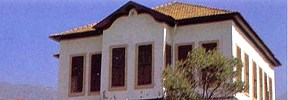 This is the house where Mustafa Kemal Atatürk, the founder of Turkish Republic stayed for a while when he visited Alanya on 18 February 1935. The owner of the house, Mr. Rıfat Azakoğlu left it to Ministry of Culture to be preserved as a museum.
This is the house where Mustafa Kemal Atatürk, the founder of Turkish Republic stayed for a while when he visited Alanya on 18 February 1935. The owner of the house, Mr. Rıfat Azakoğlu left it to Ministry of Culture to be preserved as a museum.
The three-storey building situated in a garden reflcts the 19th century Turkish architecture. In the ground floor, Atatürk’s personal belongings, photographs, the telegram that Atatürk sent to people of Alanya and some other historical documents are exhibited. The rooms upstairs are decorated with some traditional furniture.


